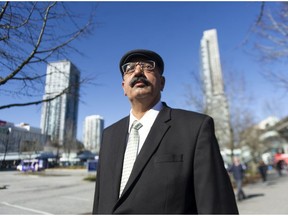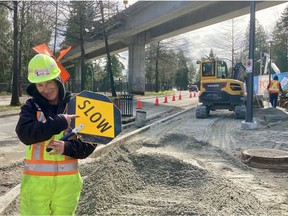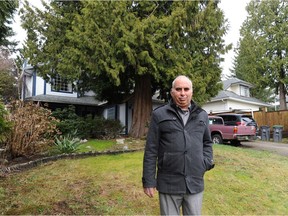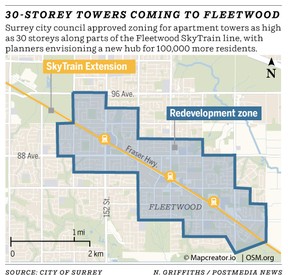Once the butt of jokes, Surrey is soon to be B.C.'s most-populous city

Article content
“The evolution of affordable luxury.”
Advertisement 2
Article content
That’s the marketing slogan a developer is using to sell its glistening new highrise in the vast construction zone that is Surrey Central, the would-be downtown core of the otherwise sprawling suburb of Surrey.
Dozens of apartment towers are starting to soar to 30 to 50 storeys in Surrey Central. The dizzying pace of redevelopment reveals itself in the way the so-called “affordable luxury” units hover above dilapidated detached houses, old drive-thru restaurants and weathered three-storey social-housing complexes.
“Look around. Thirty years ago these buildings weren’t here,” says construction flagperson Tina Hernstedt, 50, gesturing to the glass skyscrapers in and around the bustling King George SkyTrain Station.
Advertisement 3
Article content
“It’s growth. It’s happening too fast,” the Surrey resident said. “But it’s going to happen whether I like it or not.”
In 1984, I wrote a Vancouver Sun feature exploring why Surrey was the butt of jokes. Physically three times larger in size than the city of Vancouver, many then judged it to be a vast, chaotic region of ticky-tacky housing, rednecks, abandoned vehicles and problematic mayors.
It’s almost unbelievable what’s happened to Surrey since the Second World War, when it had only 13,000 residents, many of them farm families. By the early 1980s, it had exploded to 165,000 people. The mayor at the time, Don Ross, said it was the country’s fastest-growing city.
It pushes on. The 2021 census reveals Surrey’s population is 568,222, supercharged by waves of immigrants, who make up 43 per cent of residents. It’s closing in on the city of Vancouver, the most populous in B.C. with 662,248 people.
Advertisement 4
Article content
Surrey grew by more than 50,000 residents between 2016 and 2021 — a 9.7 per cent rise. It’s expanding at double the rate of Vancouver’s 4.9 per cent. Surrey is now the nation’s 11th largest city, equal to Quebec City and Hamilton.
And its growth, with such big numbers, comes with some clout.
But what kind of political influence is Surrey gaining as its population rockets? What kind of business and economic power? And what is happening to its reputation?
In the early 1980s, many forecast Surrey would have a larger population than Vancouver’s “within a generation.” That hasn’t happened yet, largely because of Vancouver politicians’ enthusiasm for rezoning for density and approving hundreds of condo skyscrapers. Although Surrey is erecting its own highrises, the year when Surrey will become the province’s top population dog is probably still 15 years away.
Advertisement 5
Article content
And people interviewed by Postmedia acknowledge Surrey does not yet have as enticing a reputation as Vancouver, which is sometimes tagged “Lotus Land.” Vancouver’s waterfront boardwalks, mountain views, trees, urbane culture, cycle paths and funky restaurants lure tourists.
Surrey, by contrast, is still trying to get over its reputation as a low-cost “bedroom suburb,” a wide-open region that retains swaths of farmland, but which is also packed with mini-malls and four- and six-lane thoroughfares, on which thundering semi-trailer trucks frequently tower over passenger vehicles.
But the old Surrey, which was a source of amusement, is transforming into something new, with a young population and emerging growth-driven power and wealth.
Advertisement 6
Article content

Surrey is starting to punch its weight in politics
In the 1970s and ’80, Surrey politics was dominated by erratic or idiosyncratic mayors. Blustering ex-mayor Ed McKitka hit the national news when he was found guilty of corruption charges. Former mayor Bill Vander Zalm put Surrey’s name in headlines by calling the premier of Quebec a “frog.”
Surrey’s reputation is still beset by contentious mayors, the latest being Doug McCallum, who was in court this year facing a charge of public mischief.
That should not distract, however, from Surrey’s rising political clout.
Vote-rich Surrey has become a crucial destination for every politicians, including Prime Minister Justin Trudeau and B.C. Premier John Horgan. Both rely on snagging most of Surrey’s seats.
Advertisement 7
Article content
Unlike “elections” in totalitarian states like Russia and China, democracy actually gives some power to people, says Shinder Purewal, a political scientist at Surrey’s Kwantlen Polytechnic University, who has also served as a citizenship court judge.
“Politics is a numbers game. And votes still count,” Purewal says.
Hamish Telford, a political-science professor at Fraser Valley University, says, “The provincial NDP have, in particular, made Surrey a fortress.”
The NDP took seven of nine Surrey seats in the 2020 provincial election — a record for the party. They were all in the northern section, where the population of many neighbourhoods is more than 70 per cent South Asian Canadian. Surrey has two cabinet ministers in the NDP government.
Advertisement 8
Article content
The federal Liberals also did unusually well in Surrey in the 2021 election. They scored four of five ridings. Yet Trudeau hasn’t bestowed cabinet minister status to anyone from the city. The federal Liberals strive to appeal to the fast-growing South Asian population, who tend to be on the liberal left, said Telford. A 2021 YouGov poll found 38 per cent supported the Liberals — with only 14 per cent voting for Erin O’Toole’s Conservatives. Another 21 per cent backed Jagmeet Singh’s NDP.
Arguably, however, municipal politics is more directly important for Surrey.
Telford is among those who say that’s been a problem, particularly with the return of combative McCallum, who was mayor from 1996 to 2005 before being re-elected in 2018. “A mayor is the face of a city,” said Telford. McCallum’s new reign “has been a setback.”
Advertisement 9
Article content
McCallum utterly disagrees. “Surrey’s rapid growth, relative affordability for new homeowners and increasing popularity as a destination for business are proof that Surrey is on the rise,” he said.
“The success we are experiencing has not gone unnoticed as senior levels of government have invested in major projects such as the Surrey-Langley SkyTrain, the new Pattullo Bridge and many other significant improvements. Surrey is a major economic generator for the Metro region, with numerous jobs created through construction and new businesses.”
Still, Vander Zalm, now 87, who went on to become a B.C. premier, is among those who think Surrey’s politics are highly conflicted.
“There will be controversy in Surrey for a good while to come. It’s growing and, in growing, there’s pain. It’ll mature over time.”
Advertisement 10
Article content
Surrey is also divided between north and south, says Purewal, with residents in the south being more well-off, more ethnically diverse and having outsized clout on council.
Telford looks forward to the day when Surrey elects a “charismatic” South Asian mayor who can unite residents.
Even though flagperson Hernstedt and others said they’re put off by politics and don’t think about the power that goes with it, Telford holds out hope that Surrey voters could heighten the city’s prestige and influence by ushering in a new leader like the City of London’s popular Sadiq Khan or Calgary’s long-serving Naheed Kurban Nenshi.
‘Bedroom suburb’ still working toward its brand
“Surrey’s brand is still not as strong as Vancouver’s, for sure. We are a very young city,” says Dianne Watts, who was mayor from 2005–2014.
Advertisement 11
Article content
Surrey’s lack of a distinct brand, of a widely held positive perception, Watts said, persists despite the efforts of her and others to create the new downtown at Surrey Central.
Watts hopes Surrey Central will give a firmer identity to Surrey.

While Watts agrees that Surrey’s idiosyncratic political leadership continues to hold the city back, she also says there are broader reasons Surrey, with its many contrasting neighbourhoods, will never be like Vancouver.
“Surrey has a land base that can fit all of Vancouver, Richmond and Burnaby within our borders. One third of our land is agricultural. Our population speaks 105 languages. We should not be comparing ourselves to Vancouver, but identifying who we are as a city.”
Advertisement 12
Article content
However, it’s hard to create a brand for a suburb, any suburb, says Telford.
“It’s tough to create a centre in a suburb.”
Whether they’re from abroad or from within Canada, he said, “people go to Canada’s suburbs mostly because of the lower cost of living.”
Until the last couple of years, Surrey housing has been considered among Metro Vancouver’s most affordable. But prices have rapidly risen during the housing boom associated with the coronavirus and extremely low interest rates.
Highrise-construction worker Ryan Kelly, interviewed while having lunch in Surrey Central, is entirely put off by Surrey’s rapid population growth and its affect on housing. “We’re being forced into shoe boxes. How can I pay $600,000 for a 600-square-foot place?”
Advertisement 13
Article content
Despite the new condos and office buildings, the reality is Surrey is still a spread-out commuter suburb, with four of five residents driving to work. With its oversized lots, it has a third of the population density of the city of Vancouver, which is the most dense in Canada.
Surrey also has only one hospital and isn’t home to a major institute of higher learning like Vancouver’s University of B.C. and Burnaby’s Simon Fraser University.
Purewal says his own institution, Kwantlen Polytechnic University, is the second choice of most Surrey students, who would prefer to attend UBC or SFU. Both those universities, he said, only have “satellite” campuses in Surrey. It’s not the same thing.
For her part, flagperson Hernstedt, who has lived in various neighbourhoods of Surrey since she was 13, puts what’s happened to Surrey’s reputation simply.
Advertisement 14
Article content
“Surrey used to have a really bad image. I think it’s got a little better, but only a little.”
Distinct subcultures and streetscapes
While Surrey has many people who have achieved a great deal, including a certain amount of fame, it’s hard to come up with a household-name associated with the city. It doesn’t have the North Shore’s Douglas Coupland, Burnaby’s Michael Bublé or Vancouver’s Ryan Reynolds.
Surrey is, however, the birthplace of Neeru Bajwa. Bajwa has become a star actress and director in Punjabi and Hindi movies. She has 4.4 million followers on Instagram.
The ethnic demographics of Surrey are much different than in 1984, when white residents predominated.
Advertisement 15
Article content
The Vancouver Sun Tue Dec 4… by The Province
The 2016 census identified white people as a minority in Surrey — making up 41 per cent of residents, compared to 49 per cent across Metro Vancouver. Ethnic South Asians, mostly Punjabis, came in at 33 per cent (12 per cent across Metro) and ethnic Chinese at eight per cent (20 per cent across Metro). Filipinos and others account for 17 per cent of residents.
While the Indo Canadian presence has created a distinct subculture in Surrey, particularly in Newton, with its Sikh gurdwaras and strong Punjabi community, acutely different subcultures and streetscapes are evident in other parts of the far-flung municipality.
The increasingly congested Surrey Central, for instance, could not be more different from village-like Cloverdale. The deluxe treed acreages of South Surrey and Panorama Ridge also contrast wildly with the warehouses and low-cost 1960s housing of Kennedy Heights.
Advertisement 16
Article content
Shivdev Parmar, who came to Canada from India in 2001 as a hospital administrator and now works as an immigration consultant, said he doesn’t think Surrey is more ethnically diverse than other parts of Metro Vancouver.
But he’s concerned how concentrated the Punjabi population has become in places like Newton. He moved his family to Fraser Heights to be part of a more “multicultural community,” where South Asian, Filipino, white and Chinese residents live side by side.
When Purewal visits England and lets South Asian people know he’s from Vancouver, they immediately ask if he lives in Surrey.
For the many citizens of Northern India who want to immigrate to Canada, Parmar said the most well-known destinations are Surrey and the Toronto suburbs of Brampton and Mississauga.
Advertisement 17
Article content
“People coming from the Punjab go to these places to feel comfortable,” Parmar said, “because they know they might get support from their community, familiar food and the same religious institutions.”
Vast economic potential and massive new infrastructure
The Surrey public school system is the largest in B.C., with 75,000 students.
Surrey’s website expounds on how one out of four of residents are under age 20, compared to one in six in the city of Vancouver.
“It really is a double-edged sword,” said Watts. “While it is great having such a young population with lots of opportunity, it also comes with some community issues because of such a young demographic. It is important to maintain and build schools, sporting fields, community centres, swimming pools, skate parks, etc. So the cost of infrastructure can be significant.”
Advertisement 18
Article content
While Parmar, who has served on the parents’ committee of his children’s public school, appreciates what teachers are doing, he also says the school system is being buffeted by endless “unexpected jumps in enrolment.” Surrey’s schools, Parmar said, can’t keep up with so many new permanent and non-permanent residents arriving with school-age children.

On another front, Surrey’s growth has led to provincial and federal governments committing to building a $4-billion extension to the SkyTrain system, which will extend from King George Station down the Fraser Highway to Langley City. This month, Surrey council approved zoning for 30-storey apartment towers along the Fleetwood part of the line, with planners envisioning a new hub for 100,000 more residents.
Advertisement 19
Article content

“There’s a lot of action going on in Surrey,” says Peter Hall, SFU’s dean of arts and a specialist in urban studies.
Will taxpayers across Canada, B.C. and Surrey support paying for the infrastructure that will help turn Surrey into what Hall calls a future “economic heavyweight?”
Surrey is on the cusp of generating great business power for itself, Hall said, in part because it has the region’s largest base of developable industrial land, especially in Campbell Heights and around the Surrey Fraser Docks.
While Surrey might lack the “sexy” digital and cultural industries that characterize the city of Vancouver, Hall said much more residential and commercial density is also advocated in Surrey Central, Fleetwood, Port Kells and the South Surrey border with White Rock.
Advertisement 20
Article content
For his part, Parmar said he’s pleased that elevated economic growth will likely make it possible for his three children, if they desire, to eventually find jobs in Surrey. “As long as they don’t go into the high-tech industry, they won’t have to leave here to get work.”
Purewal, who lives in the green, expansive neighbourhood of Fleetwood, offers a few discouraging words about infrastructure, however.
When Purewal had a stroke a couple of years ago, he said Surrey doctors eventually suggested he go to Royal Columbian Hospital in New Westminster because the treatment there would be more sophisticated.
He doesn’t believe Surrey gets its fair share of hospitals, given its size. While the B.C. government has promised a second hospital for Surrey by 2027, Purewal notes the city of Vancouver has long had three major hospitals.
Advertisement 21
Article content
And even though it can seem exciting to be a young city, with a high proportion of youth, almost everyone interviewed lamented how recent housing price jumps in Surrey are pushing young families further out into the Fraser Valley or into cramped condo units.
“The whole housing market has gone nuts. Something’s gotta give,” said Vander Zalm, whose family lived on an acreage in Port Kells when he was mayor.
Vander Zalm, who now lives in Ladner, reluctantly recognizes there may be a need for more highrises in Surrey. “I’m still a farmer at heart: I don’t have to like highrises and I don’t have to live in them. But if I were younger, I would probably have to learn to like them.”
Despite Surrey’s considerable growing pains and struggle to create an attractive brand, my 1984 feature suggested maybe, in the end, its residents will get the last laugh. And that’s become more imaginable than ever.
Advertisement 22
Article content
The city’s political and economic clout is amplifying. Its own special character is emerging. Some of its potential has already been realized — and there is a great deal more to come.
When mulling Surrey’s future, Purewal quotes a famous line from the American novelist Edith Wharton: “There are two ways of spreading light — to be the candle or the mirror reflecting it.”
Many residents of Surrey don’t want to try to copy the city of Vancouver. That’s probably impossible anyway. They’re yearning for Surrey to create its own candle, its own light.
More news, fewer ads, faster load time: Get unlimited, ad-lite access to The Vancouver Sun, The Province, National Post and 13 other Canadian news sites for just $14/month or $140/year. Subscribe now through The Vancouver Sun or The Province.
Fast-growing Surrey can finally look forward to wielding some clout - Vancouver Sun
Read More



No comments:
Post a Comment